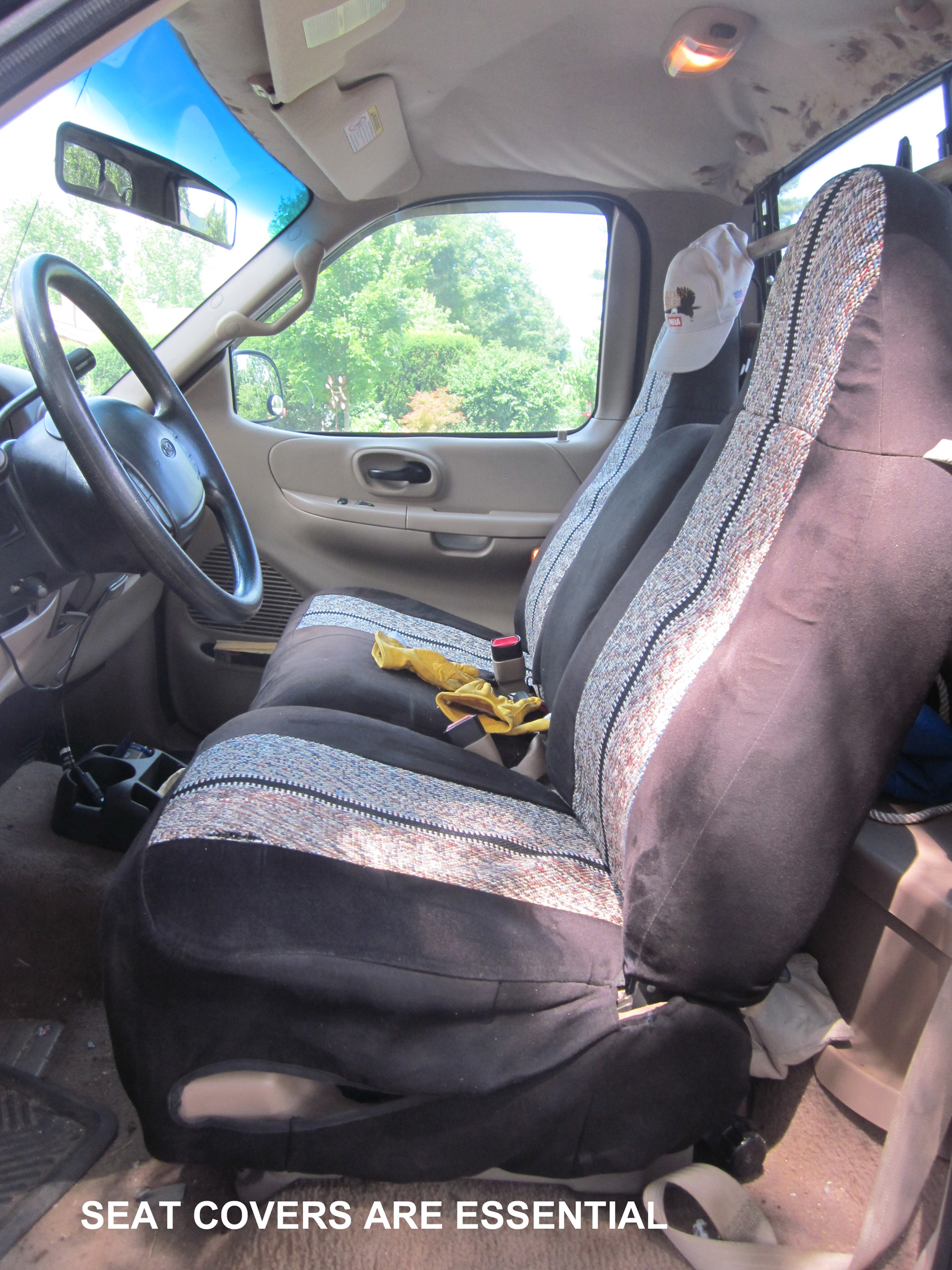 You may not drive your truck every day (in fact you probably won't) but at certain times of year you may spend a fair amount of time in it. Therefore there are things it should have to ensure that it meets your needs, even unanticipated ones.
You may not drive your truck every day (in fact you probably won't) but at certain times of year you may spend a fair amount of time in it. Therefore there are things it should have to ensure that it meets your needs, even unanticipated ones.I like trucks. There was a time in my life when I didn't, when they didn't "make any sense" to me, but that time is long gone. When we were exiled to College Station, Texas (where Hell is a quarter-mile away and the fence is down) I laughed at people who had a truck as their only vehicle: but once I got my own, I realized what I'd been missing, and I'll never be without a truck again. Anyone who is interested in any sort of outdoor activity needs a truck of some kind.
Over the two decades I've been a truck owner I have learned enough to have developed a philosophy about what a truck is and should be. First, it's important to realize that a truck is about hauling stuff, not people. I don't much care for "extended" cabs, and while I might buy a truck with one, I'd never get a "crew cab." I'd rather use that additional length to make the bed longer. I have friends whose trucks have 4-person cabs, but they use the back seat very little. So why bother?
Second, bed length matters. This principle goes hand in hand with the first, because a bed is for cargo. A long bed will allow you to carry much more stuff.
Third, four wheel drive is essential. Unless someone lives in a city where he will never, ever drive on unpaved roads, I can't imagine owning another 2WD truck for any reason. Even gentle pastures can have slick spots; even a light skiff of snow can cause traction problems. The 4WD truck takes these in stride, the 2WD drive truck lies down and cries in horror at the prospect of a wet slope.
Fourth: bigger is better. I have no use for Tonka-Toy sized trucks, or even "medium sized" trucks. My current F-150 is considered a "full sized" vehicle but in truth it's smaller than I desired. I preferred the big F-250 on that score, and if I could get away with it I'd buy one of those gargantuan F-350's Ford makes. A small truck is OK if the biggest thing you have to carry is a barbecue grill, but it's not much good for anything else. Even with the shorter-than-optimal bed I have now I can carry a full-sized chest freezer, a grand piano, a sectional sofa, or a ton of mulch. Yes, it's "overkill" for a deer, but it's just the ticket for a 16-foot canoe, an outboard motor, and miscellaneous boating gear.
Fifth: Gas mileage is unimportant. No real truck gets good mileage but that doesn't matter. Trucks are for short-haul trips for the most part. One rarely will drive a truck as much as 250 miles one way: usually the round trip is 20-25 miles or so. You can't save enough money by setting fuel economy as a priority for purchase to offset the difference in price between a big and a little one, which negates the chief advantage of a small truck. Trucks, by virtue of their design, aren't streamlined and they aren't fuel efficient, but they needn't be to be useful.
Sixth: An automatic transmission is acceptable, though a manual is preferable if you can drive one. In his delightful book First Person Rural: Essays of a Sometime Farmer Noel Perrin makes the case for the automatic by pointing out that in creeping over a field at very low speed, scanning for rocks, it's much easier to control the truck. I'll agree to this but point out that with a 5-speed (or even 4-speed) manual, low gear gives comparable slow speed handling.
Seventh: Power matters. There is no point to a 4-cylinder truck other than fuel economy. A 6-cylinder engine is good; an 8-cylinder engine is better. More power translates to more torque, and hence lower operating RPM at any speed; this means less wear-and-tear on the engine's innards.
 You may not drive your truck every day (in fact you probably won't) but at certain times of year you may spend a fair amount of time in it. Therefore there are things it should have to ensure that it meets your needs, even unanticipated ones.
You may not drive your truck every day (in fact you probably won't) but at certain times of year you may spend a fair amount of time in it. Therefore there are things it should have to ensure that it meets your needs, even unanticipated ones.
One of the first things to do is to install a gun rack in the rear window and a set of Cabela's "Indian style" seat covers, preferably the kind with the pockets in front where you can stash things. Inevitably if you use the truck for fishing or hunting, the cab will get dirty. Mud, fish scales, worm dirt, leaves, squirrel hair, you name it: all that is going to find its way in.
In addition to keeping the seats clean for when you do want to part with the vehicle, most utility trucks have those execrable vinyl seats; good tight cloth seat covers keep you from sliding around on them. In the pockets of the seat cover, you should have pencils and pens, and maps. While you're fitting up the cab interior get a couple of generic rubber floor mats that will trap mud and water and "preserve" whatever carpet is in place.
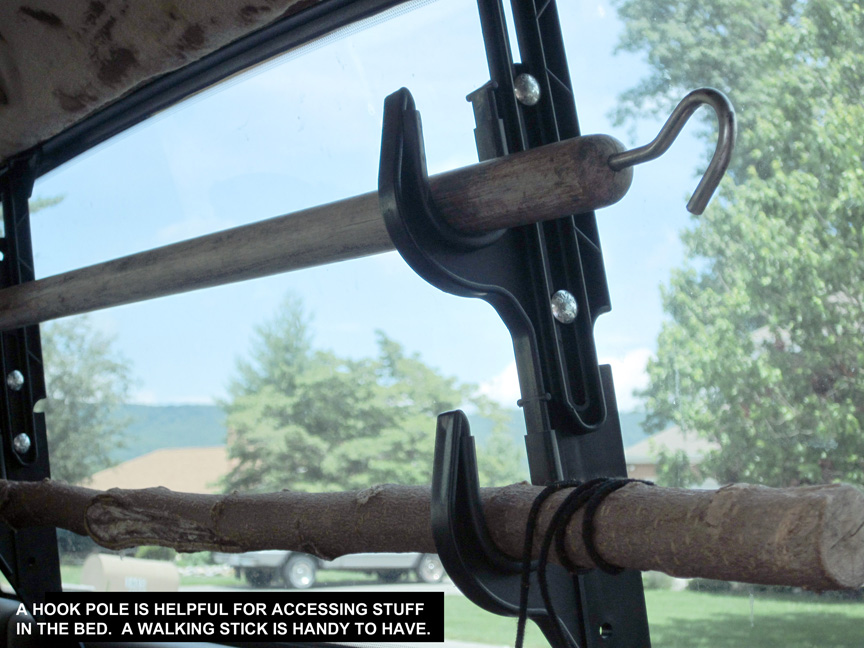 A back window gun rack is a good place to keep a 5-or-6-foot-long piece of broomstick with a steel hook screwed into one end. This device is a real aid in getting stuff up in the front of the bed to where you can reach it from the tailgate. I also have a rough-and-ready walking stick there, should I get out on uneven ground.
A back window gun rack is a good place to keep a 5-or-6-foot-long piece of broomstick with a steel hook screwed into one end. This device is a real aid in getting stuff up in the front of the bed to where you can reach it from the tailgate. I also have a rough-and-ready walking stick there, should I get out on uneven ground.
Behind the seat, you will need at least 100 feet of stout rope, a fire extinguisher, and a couple of dog leashes in case you come across a stray dog (which happens to me every 6 months or so). In the winter you should have de-icing spray and a window scraper. A blanket is nice. Other must-haves include a half-hatchet (which doubles as a hammer), a roll of duct tape, some vinyl tape to seal hose leaks, at least one good flashlight, a roll of paper towels, and jumper cables.
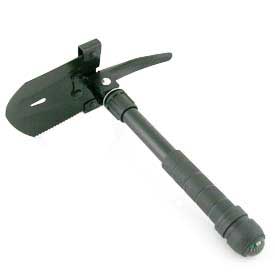 All year long you should have a folding shovel. Assuming you may be driving into the woods, a decent folding pruning saw is worth having as well. By the way, a roll of toilet paper can save your day, by all means have one of those! A bale of assorted bungee cords and a nylon tarp big enough to cover the bed. A canteen or two of water. Whatever tools may be needed for running repairs: at least two quarts of engine oil. A spare serpentine belt, as bitter experience has taught me (see below). Optional items include a small broom to sweep out the bed, and whatever odds and ends you think might be handy.
All year long you should have a folding shovel. Assuming you may be driving into the woods, a decent folding pruning saw is worth having as well. By the way, a roll of toilet paper can save your day, by all means have one of those! A bale of assorted bungee cords and a nylon tarp big enough to cover the bed. A canteen or two of water. Whatever tools may be needed for running repairs: at least two quarts of engine oil. A spare serpentine belt, as bitter experience has taught me (see below). Optional items include a small broom to sweep out the bed, and whatever odds and ends you think might be handy.
 No truck is really complete some bumper and window stickers. I have ones for various organizations of which I'm a member, one saying "Fish Tremble When They Hear My Name," and one to indicate that "My Border Collie Is My Co-pilot." One that often gets a chuckle from people following me are the ones that say"Squirrel: The OTHER White Meat," and "Squirrel: It's Not Just For Breakfast Any More." Finally I put one there advertising the local public radio station (to which I don't listen, but it keeps people wondering what kind of nut drives that thing).
No truck is really complete some bumper and window stickers. I have ones for various organizations of which I'm a member, one saying "Fish Tremble When They Hear My Name," and one to indicate that "My Border Collie Is My Co-pilot." One that often gets a chuckle from people following me are the ones that say"Squirrel: The OTHER White Meat," and "Squirrel: It's Not Just For Breakfast Any More." Finally I put one there advertising the local public radio station (to which I don't listen, but it keeps people wondering what kind of nut drives that thing).
Here's one other item you simply must have: a spare key for your door. I once managed to lock myself out of my truck on a zero-degree day, miles from anywhere civilized, on a road that sees almost no traffic. Had I not had a cell phone signal, and been able to call 911, my stiff, frozen corpse would have been delivered to my wife eventually. Even if your truck has the kind of key with a chip in it, you can get a "duplicate" that will at least allow you to open the door to retrieve the functional key you locked inside. Put the spare in one of those magnetic boxes and hide it in a secure spot. If someone does find it they may be able to steal your stuff but they won't able to steal your truck.
TRUCKS I HAVE OWNED
My trucks usually end up ugly even when they don't start out that way. The truck-of-the-moment starts out looking pretty good, but quickly enough, it gets beaten up because it's used as a truck, not a general transportation vehicle. I demand that it do things that ding it, bend parts, and scratch the paint. These are all are par for the course, signs of honest use. My wife is dismayed by this philosophy but she has come to accept it. I doubt if I ever will drive one that isn't an eyesore and an abomination in the sight of The Lord, sooner or later.
My first truck was a 1983 GMC Sierra 1500, a "pretty" one I bought from my father-in-law. He'd got it as a retirement present to himself. He was a meticulously neat man, the sort of person who washed, steel-brushed, dried, and oiled his garden shovel every time he used it. The idea of keeping a truck out in the driveway was anathema to him: birds might poop on it. When he wasn't actually driving it, he kept it in a garage. But the poor man's knees gave out a few months and 10,000 miles into his ownership, and he never drove it again. It spent the next decade in the garage, coming to me essentially pristine.
The GMC had a soft bench seat, a plush blue cloth headliner, a 4-speed automatic transmission, nice carpeting, power everything, and was a peculiar shade of iridescent blue that GM called "Midnight Mist," or some such name. Best of all, however, it had a honkin' big aluminum cap on the back with a roof rack that would hold my boat. I paid my father in law his very modest asking price and drove it home proudly.
It was 2-wheel drive, which meant that it was really a stay-on-the-road type machine, a sort of glorified roadster; but I was inexperienced and didn't know at the time that a 2-wheel-drive truck is about as useless a utility vehicle as could be imagined.
With time I became less enchanted with the GMC, but it had the virtue of making me more than ever convinced that I did in fact need a truck. The 2-wheel drive was a real problem, so was the weight distribution. At the time I was spending a lot of time on a farm that had steep grassy hills. If the grass was wet, there was nowhere near enough weight in the back end to give me the traction to get up. Worse, it was so light in the rear that even on dry roads it had an alarming tendency to skid on curves, a process called "weathervaning," where the truck spins around the weight of the engine. One day I damned near killed myself when I braked incautiously on a back road and threw it into a spin that nearly sent me down an embankment.
In my hands it became ugly. A couple of years into its time with me it acquired a big dent in the right side where I clipped someone as I pulled out of a parking space. Over time it lost several pieces of chrome.
Eventually the headliner peeled off. I put old bath mats on the floor to protect the rug (ha, ha). It developed various splits and cracks in the dashboard plastic. I installed one of those plastic "consoles" on the middle of the seat, that you get at Wal-Mart for $3.00 because GM hadn't invented cup holders in 1983. It also eventually got a cup holder screwed into where the leather strap to close the door used to be. One window button was broken off, but it worked if you stuck a knife blade in it. By the time I got rid of it in 2003, it had lost all of its original posh appearance and taken on the Redneck patina a truck is supposed to have.
In short, it became a statement: my Change Of Life Truck. Blacksburg isn't Madison, Wisconsin, nor yet Ann Arbor, Michigan; but Political Correctness lives here in southwestern Virginia, too, especially on campus. I liked the idea of a Redneck truck with a senior faculty member behind the wheel. One day I got out to fuel it at a Mom & Pop gas-and-go in the country. The guy next pump over, filling up a Lexus, was the Provost. It's true: tenure means never having to say you're sorry.
Aside from 2-wheel drive that got me stuck more than once, and aside from its driveability issues, the thing was an out-and-out mechanical and electrical disaster, even when it was new. God knows what GM used for paint in the 80's but it was simply awful. It became chalky, it flaked off, it faded to primer, and all of this was accelerated by the rust. Not that paint is much of an issue for me, really, it sort of adds to the aura of "lived in." But it shouldn't start peeling with a few months of exposure to the elements.
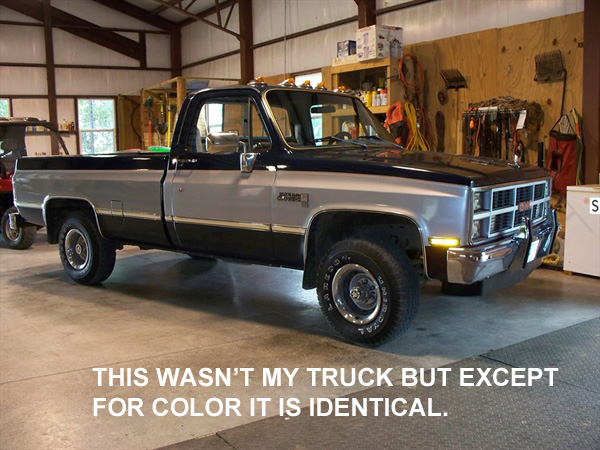 But the worst aspect of that truck was its propensity to break down. In fact the only thing I could rely on was that it would stop running when I needed it. Much of this was due to it being a "transitional" vehicle, made at the very beginning of the conversion from purely mechanical control systems to on-board electronics. It had a very primitive "engine control module" that would whimsically take a day off, usually when I was driving somewhere. The truck would simply stop dead in the middle of the road. If I gave the ECM a while to think about things it would re-start, most of the time. When it didn't, it was time to get towed.
But the worst aspect of that truck was its propensity to break down. In fact the only thing I could rely on was that it would stop running when I needed it. Much of this was due to it being a "transitional" vehicle, made at the very beginning of the conversion from purely mechanical control systems to on-board electronics. It had a very primitive "engine control module" that would whimsically take a day off, usually when I was driving somewhere. The truck would simply stop dead in the middle of the road. If I gave the ECM a while to think about things it would re-start, most of the time. When it didn't, it was time to get towed.
Once this ECM issue was diagnosed there wasn't much to be done about it. There were no new ECM's of the correct type to be had: they were only used for that one model year because shortly thereafter GM went over to fuel injection (my truck was carbureted) and changed the entire design. The only source was a junkyard...and there was of course no guarantee that would provide one that was any better.
One day the automatic transmission spontaneously self-disassembled at 65 miles per hour on Interstate 81 near Harrisonburg, stranding me 125 miles from home. It felt like I'd been hit in the rear bumper, and the beast juddered to a stop, the transmission totally locked up to the point where I couldn't move the shift lever. I had it towed to a nearby repair shop. As the tow driver was unloading at the garage, the mechanic remarked, "I bet you got about 80,000 miles on it." I asked how he knew that and was told, "Ahh...all them GM four-speeds do that at 80,000 miles." When I recovered it, $1300 and a week later, he handed me a 6-inch chunk of the ring gear that had snapped loose and jammed the rest of the gears up solidly.
I should have abandoned it then and there, but my wife was mad enough that she had to come and fetch me and later drive me back to get the truck: no way would I have been able to convince her to buy another truck right away. So I drove it home, wondering if (when) it was going to happen again.
Over the next couple of years it continued to nickel-and-dime me with repairs, usually electrical stuff. Finally I had had it: my wife's brother in law was then operating a candy-and-vending-machine company, and said he'd like to have it, so I gave it to him. He put $3500 into it—even having it repainted!—added a lift gate worth more than the truck, and it ended its days hauling pool tables and pinball machines around central Ohio. It may still be there for all I know, but I suspect that it's in the GM Organ Donor Program now. Good luck to anyone who gets the ECM from it!
For a few months I went truck-less, but Fall was approaching and something had to be done: by that time we'd sold the Honda Civic and acquired a brand new Volvo wagon; I needed a truck, so off I went to make the rounds of the used-truck lots for a replacement.
My wife can't drive a manual transmission vehicle, and I had been cautioned that if I were to buy a second truck, it had better be an automatic. I'm not a fan of automatic transmissions: I don't think you have the same control over the vehicle that a manual gives you. I dutifully looked at the available vehicles in a 15-mile radius, but everything with an automatic was priced out of my budget. There's a local shop that specializes in used trucks (I will call it "Redneck Motors") which was one of my frequent ports of call. One day they had a very nice looking four-wheel drive Ford F-250 Super Duty on the lot at a reasonable asking price. It was, however, a manual, a 5-speed. I asked to drive it. I liked it. I bought it. I broke the news to my wife.
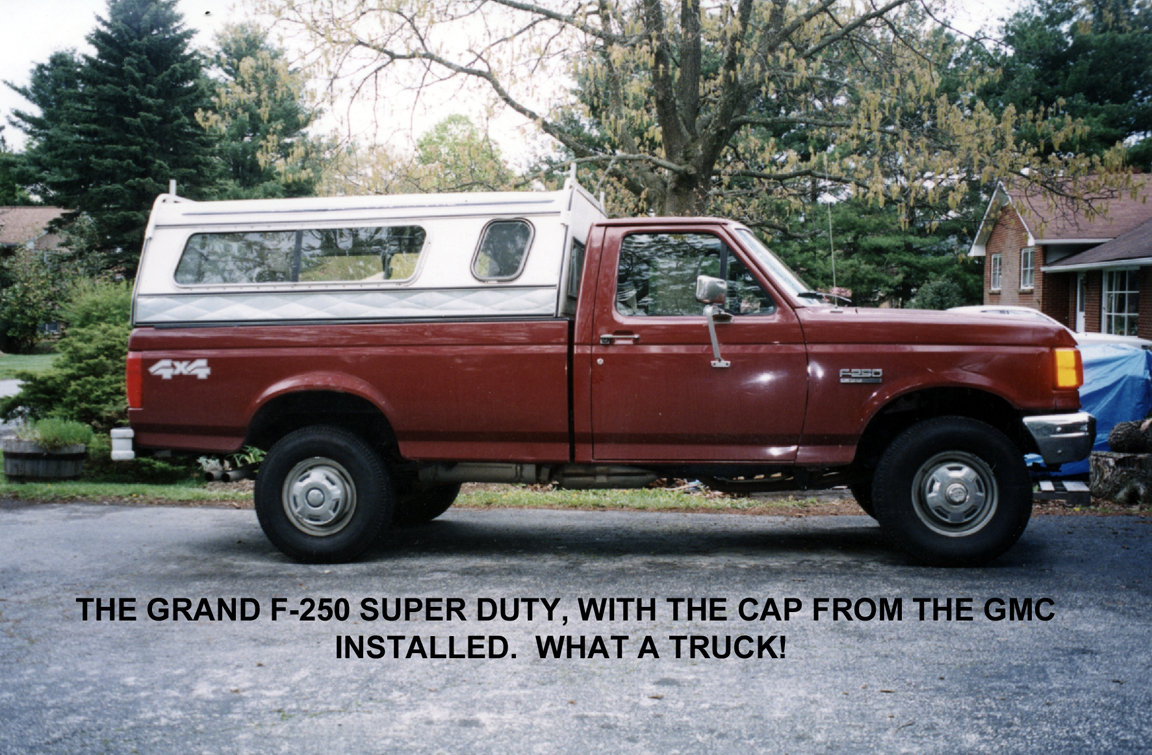
That F-250 was considerably larger than the GMC had been, and one reason I bought it was that it had an 8-foot bed. The aluminum cap from the GMC would fit the bed, saving me the cost of a new cap. There was a time in this Fair Land when an "8 foot bed" was just that: and all trucks of all makes with such a bed were the same size. This is no longer the case, and today trucks are sold with "long bed" or "short bed" designations, which mean different things to different manufacturers. But the 1991 F-250 had a bed the same size as the 1983 GMC, so as soon as I got it home the cap went on.
As much as I liked F-250, it lacked some things I'd become used to, mainly power windows and door locks, but these were minor things: the cap was the essential feature. It turned the open bed into a sort of mobile storage unit for fishing and boating gear, and other junk that I like to carry around. All the miscellaneous objects from the cab were transferred to the "new" truck and I drove it until December of 2014. I added a hitch ball to tow the boat trailer I'd bought by that time. The top of the cap was more than 7 feet above the ground; hoisting a 110-pound boat up there had become a bit much for me, hence the trailer.
My wife hated the F-250 even more than she hated the GMC. She couldn't drive it; the wheels were so large and the ground clearance so high she had trouble getting into it; and it was big, scary, and noisy. But it went wherever I commanded it to go, never once got me stuck, and affirmed my opinion that four-wheel drive is THE way to go.
One thing I never have understood, though, is the thinking of the designers who set up the transmission. In the Ford 5-speed of the time the hydraulic slave cylinder—a $25 part—is inside the transmission housing. To replace it necessitates removing both the transfer case and the transmission, and re-assembly: a job requiring $800 in labor! How do I know this? Because one day my slave cylinder went and I ended up spending that much and more to get it replaced. At the same time I went ahead and had a new clutch installed because, as the manual put it, "The cost of labor is much the same and it is worth while to do both jobs at once."
That was pretty much the only mechanical issue I had with it until late in its time with me. Over the years it acquired numerous bangs and bumps, including a bashed-in passenger side door that resulted from sliding into a fence on a snowy hill. The Bondo that had been used to build up pre-purchase bashes eventually fell out; the paint wore away and the wheel wells rusted. But even after 11 years of reasonably hard service with me, it ran well. In time I had the engine replaced with a Ford re-build, warranted for 3 years: and thereby hangs a tale of sorrow and injustice done.
In December 2014 I was in a pretty remote area when, driving home at dusk, the serpentine belt snapped because the air conditioner compressor had seized up. I was in a place where I couldn't even get a cell phone signal. I drove the truck to the Interstate, but along the way it overheated to the point where it simply shut down. By then I could call a tow, so I had it taken to a garage and had the radiator replaced, the broken A/C discarded, and...it still didn't run right.
This was 2-1/2 years after the engine replacement so it was still "in warranty." But when I had it towed to the Ford dealership in town, they refused to honor the warranty at all! Their argument was that I had purchased the engine through a different dealership and they weren't obligated to service it. A lawsuit ensued, and while I may have lost the case at least they were put to the trouble and expense of getting a lawyer and sending someone to the courtroom.
So there I was with a vehicle in which I'd sunk a lot of money but that I didn't dare drive lest it completely disintegrate. Something had to be done, and clearly what had to be done was to buy a replacement.
After some efforts to sell it, Redneck Motors came to my rescue. They bought it from me for about 10% of what I'd paid them for it 11 years before; I'm sure they made money on it because the brand-tires alone were worth more than that, plus the salvage value of the parts, assuming they didn't fix it up. I saw it on their lot for a while afterwards while I hunted for a replacement.
The quest for a "new" truck began. In early 2014 we'd bought my wife a brand new Kia van at a local dealership. All the dealers here participate in the on-line "display" of their used vehicles, and this one had a listing for a nice-looking Ford F-150: 4WD, A/C, stereo/CD player, power everything (including side mirrors!) and miscellaneous bells and whistles. It looked good. I went to see it, and pointed out to the salesman that I had three months before purchased a nice shiny new car from him, and expected him to take that into account in the price negotiations. He did. In the end we compromised at $1000 below his asking price and I drove it home.
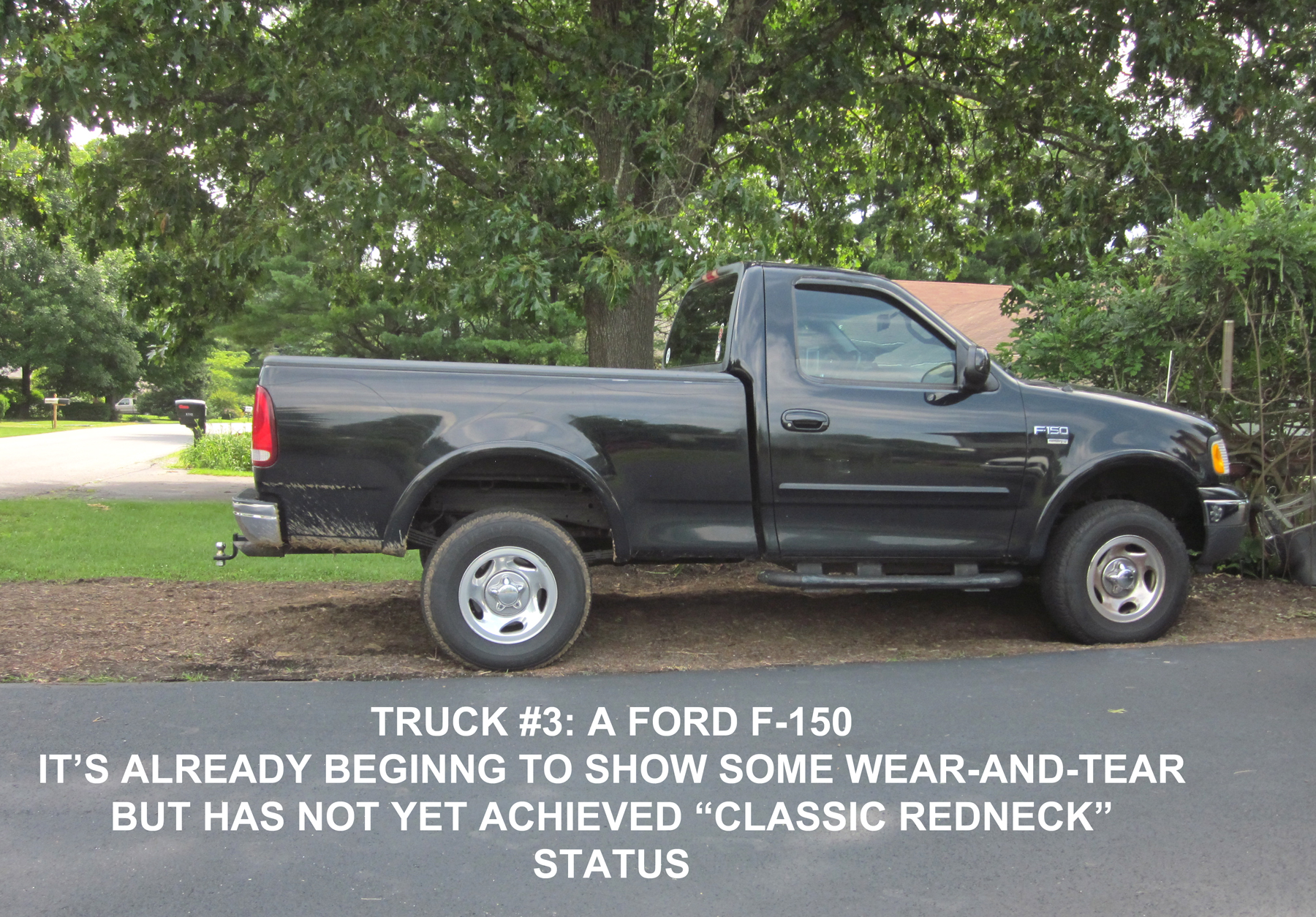
It had an automatic transmission, however. This pleased me less than it did my wife. Moreover the 4WD was not manual but electrical, a knob on the dashboard being turned to engage the transfer case. I was dubious about all this automaticity but it's virtually impossible these days to find a full-sized pickup truck that has a manual transmission: I'm not even sure they're still being made in the USA. In the ensuing years that electrical $WD system has given me endless headaches and expense but the price of even a used truck these days makes it economically sensible to keep it in repair. I've adopted the policy of switching to 4WD ever time I start the engine just to be sure it's still functional.
There were compensations, including those power side mirrors, an A/C that really works well; four new tires, plus a couple of ready-installed hitch fittings for my trailer or a big tow-behind RV that I don't (and never will) have. Unfortunately it has a "short bed" all of 6-1/2 feet long, so my old cap was useless. Being made of aluminum, it was recycled and I now have an open bed.
This business of an open bed is something my wife likes. She can now make me haul mulch and brush by the ton, which the cap prevented. The "new" truck has already made many runs to the county landfill, excuse me, the transfer station, with yard waste and junk; it has dragged several tons of yard waste to the transfer station and hauled home several more tons of mulch (mulch is the Devil's Handiwork, but that's a theme for another essay) to spread on the yard. It will (just barely) fit through the gate to the back yard, which was way too small for its predecessor. I can live with it.